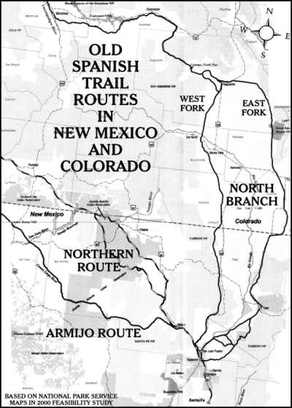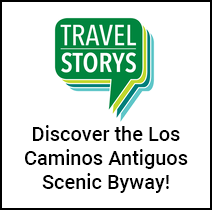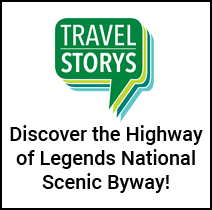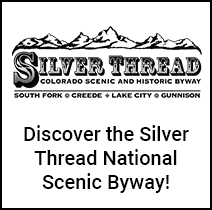Assumption 2: This area can offer traditional animals, plants, religion, sincerity, and resistance to what some call progress. History is evident here in commerce, farming and ranching methods, evidence of religious traditions, sense of New Mexican methods in agriculture, and museum, churches, and other traditions. Local skills, practices, and interpretation offer clear senses of the past in the late 1840s to 1850s. A number of books and reports can be made available at book stands. And traditional activities, personal encounters with local residents and programs can likewise enrich the sense of the past.
The Old Spanish Trail field trip seeks your intelligent comments and wisdom. How can the Old Spanish Trail Association (OSTA) present some of its stories here, while emphasizing the history and sense of the past as related to the OST? It is thought by many of us that this special and beautiful place will be one of the favorites and most genuine of the entire trail (approximately 2400 miles round trip).
The tour starts in Costilla New Mexico Plaza. (On the CO/NM State line). This is a place with a big annual art festival--amateurs and professionals every early fall. Its creek is one of the several that come down from the Sangre de Cristos. We'll go a few miles East and then northward (the route indicated by Congress for the OST.) As we go we'll encounter various crops and other photo opportunities. (2 locations). Several of the ranches are working with Churro sheep, but they may be grazing high up. I hope to do a little exploring into the Sangre de Cristo low slopes, where you can get a glimpse of the remaining rural communities and irrigation techniques. Then we'll see the last functioning commons in the USA (probably), shared by local farmers on a strict schedule.
We'll go into town (San Luis), passing diverse churches on the way. One farmer invites us to go 1.5 miles out of town to see his techniques. In town, we'll look at a thing or two, then choose our lunch from the three restaurants (or sack lunch). I hope we may see the still-renovating museum, which has a treasure trove of good information and exhibits.
Next, we'll hike up the Stations of the Cross, sculpted by Huberto Maestas, on a beautiful uphill walk and much more. At the top is a spectacular view of the Sangre de Cristos and much of the San Luis Valley. In case you're sore footed, there is a way by car, but you'll miss much of the art - a small version of this is in the Vatican collection. (You'll probably be passed by young mothers carrying an almost born and pushing an older child.) From here, we'll see what the clock says and offer alternatives for your return home.
If you go back South (on asphalt), you may see wild horses along the way. I've noticed that they are quite positive that they have the right-of-way. If time is not of the essence, we suggest that you can go north to the base of Mount Blanca, where you may be moved by its splendor—four tribes consider it sacred. Kit Carson was top soldier at Fort Garland here. North of there are some splendid hot springs. In Alamosa are some very nice motels and restaurants. You can also go to New Mexico by cutting west across the lower San Luis Valley, say hello to a famous boxer, then aim for Española and Santa Fe.
No charge except your gas and meal. If you prefer an overnight stay in San Luis, you have two choices: a convent near the church or a nice looking tucked-away big motel (many tours come to the community). Several other motels and a great steak house are in Fort Garland--16 miles North with a State Museum.
ARRIVAL by 9:55 a.m. on August 19
If you are from New Mexico, take highway 522 to Costilla, turn right and hitch up to the Plaza's parking arrangements. If you are from Colorado, take highway 159 then a left turn off 522 into town and find the same Plaza
Questions: Doug Knudson 89 Fir Drive South Fork, CO 81154
douglasfir636@gmail.com719-873-5239
A good read: Chapter 14 of Tom Wolf's - Colorado's Sangre de Cristo Mountains.
OST takes you Near to21 ofColorado's Top Wonders
On 3 Old Spanish Trail branches
San Pedro Mesa (aka Wild Horse Mesa)
- Culebra Peak, the most southerly of our nation's 14,000' peaks
- The town and country of San Luis—first in Colorado in many things
- Mount Blanca and neighboring peaks
- Great Sand Dunes National Park and Reserve
- Monte Vista National Wildlife Refuge (and neighbors)
- Wheeler Geological Area (distant)
- Conejos River Valley (side trip)
- Chimney Rock National Monument
- Mesa Verde National Park
- Navajo State Park (on Southern Ute Reservation)
- Cochetopa Pass and Continental Divide crossing
- Black Canyon of the Gunnison National Park
- Carefully Restored Trading Post (Delta)
- Gunnison Gorge Wilderness (Delta area)
- Grand Mesa National Forest (near Grand Junction)
- Colorado National Monument
- Bookcliff Views
- Ute Mountain Ute Tribal Park
- Canyon of the Ancients National Monuments
- Hovenweep National Monument
These features were selected as outstanding by Colorado's tourism promoters. The Old Spanish Trail has been a series of scenic wonders for many years.
Old Spanish Trail Association - La Vereda del Norte Chapter appreciates your interest.














